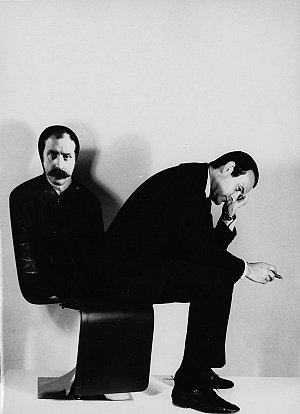
Movie camera Duplex 9,5 mm for Pathé, 1954
Roger Tallon’s archives
© ADAGP, Paris / photo : MAD, Paris
In the 1950s, when the concept of “design” was still largely unknown in France, Roger Tallon was hired as a consultant by Dupont de Nemours and Caterpillar. These American firms were developing design as a global activity and an integral part of their corporate structure. Discovering American work methods, he masterminded numerous projects, notably for Frigidaire, a branch of General Motors, for whom he worked for seven years.
In 1953, Roger Tallon joined the design agency Technès. Working alongside its founder Jacques Viénot then his son Henri until 1973, he innovated in fields as wide-ranging as machine tools, home economics, cameras, typewriters, televisions and office furniture, designing more than 400 industrial products.
During his years with Technès, Roger Tallon developed his awareness of design’s complexity and its integral role in society at all levels. Seeking to fully pursue this global concept of design, ranging from the product itself to the company’s brand image, he left Technès in 1973 to create his own agency, Design Programmes SA. Over the next ten years he filed more than 200 patents, models and brands. Taking a systematic approach to each project, involving every aspect of design, the product became a component of an overall concept.

Portable television set P111, Téléavia, 1963
Roger Tallon’s archives
© ADAGP, Paris / photo : MAD, Paris
In 1963, his formally innovative Téléavia P111 portable television was a huge commercial success and is still a cult object today. He continued to ingeniously reinvent our daily lives with other “success stories” such as the 3T tableware, the Cryptogamme stools for Mobilier National, the Mach 2000 wristwatch range for Lip and the oilcans for Elf.
Transportation is one of the fields in which Roger Tallon worked most extensively and which he was most proud of. In 1968, he designed the Mexico City Metro, and in the early 70s he began his long-term collaboration with the SNCF (French National Railways), first designing the Corail train (named by Tallon after his “comfort on rail” concept), then the TGV Atlantique and TGV Duplex, and later Eurostar in 1994. He also worked for RATP (Paris’ transport authority), designing the route maps for the RER (Paris’ high-speed rail network), the metro MP89 (line 14) and the new Montmartre funicular railway in 1991.

“TGV Duplex” external livery, 1994
Roger Tallon’s archives
© ADAGP, Paris / photo : MAD, Paris
Tallon applied his global concept of design, encompassing ergonomics, color, lighting and even the route maps in the trains, to all these projects, with the sole aim of designing objects and spaces for evolving lifestyles.
His long collaboration with the Galerie Lacloche produced iconic pieces such as the “metamorphic trapezoidal bed,” the M400 furniture range, the Module M400 and TH spiral staircase, later produced by Sentou. For Sentou, he also designed the Wimpy chair and the TS folding chair, a model of formal and graphic simplicity. These projects were the fruit of his constant professional commitment to the firms, galleries and design publishers with which he worked.
Roger Tallon realized very early on that design is not limited to the product or object itself but also has a cultural dimension, and he developed close ties with the contemporary art world, working with artists, notably with Yves Klein and César.

Siège-portrait (Portrait-Seat) of César, Orly airport Christmas crib, 1967
Roger Tallon’s archives
© ADAGP, Paris / photo : MAD, Paris
In 1966, César was commissioned to create a Christmas Nativity scene for the Orly airport. Together, they produced the Sièges Portraits (Portrait Seats), depictions of contemporary celebrities such as Mireille Mathieu, Brigitte Bardot, General De Gaulle, Salvador Dali, Picasso, the singer Antoine, Léon Zitrone, César and Roger Tallon, on whose laps one could sit and watch the Infant Jesus on a television installed among bundles of hay…
In 1970, he became the artistic director of the French Pavilion at the Osaka World’s Fair, for which he created the Têtes parlantes géantes (Giant Talking Heads), casts of the faces of the singers Françoise Hardy, Johnny Hallyday, Sylvie Vartan and Georges Moustaki, on which were projected films of these artists performing.
As a close friend of Catherine Millet, founder of Art Press, Roger Tallon designed the magazine’s graphic image and page layout in 1973, which is still the same today.
In 2008, Roger Tallon chose to donate his archives to the Musée des Arts Décoratifs. Covering his entire career, they comprise drawings, technical plans, photographs, descriptive notes, press cuttings, marketing and communication dossiers, contracts, patent applications, etc., and give a full insight into the “Tallon system”.
It is the dynamism, complexity and unique career of this many-faceted creator that the Musée des Arts Décoratifs is now fully revealing to the public. After the exhibition at the Centre Pompidou in 1993, “Roger Tallon, Design in Motion” is the first comprehensive retrospective of this iconic French designer.